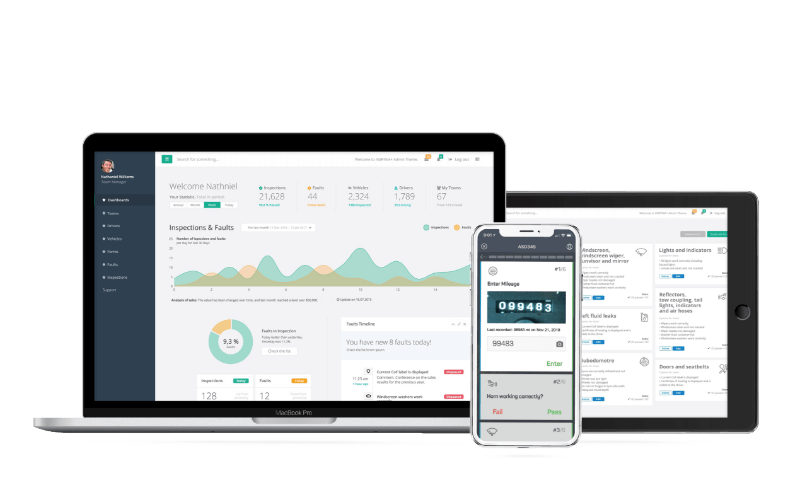While you may be required by law to complete DVIR reports, you may ask yourself “How long should I keep these”, or “where and how should I be creating and keeping these?” All are important questions to get right in order to stay compliant, especially as you grow your fleet.
When it comes to record retention, there are a few things to know in order to, not only comply with DOT regulations but also to protect the assets you depend on by using this collected information to be proactive.
In this post, we’ll break down these federal guidelines on how long to retain your DVIR records, where to keep them, and a few best practices you will want to embrace moving forward.
How Long to Keep DVIR Records
According to the Federal Motor Carrier Safety Administration (FMCSA), the DOT agency responsible for regulating the trucking industry in the United States, a motor carrier is responsible for retaining the original copy of each DVIR and the certification for repairs for at least 3 months from the date that the report was prepared.
While these 3 months are necessary for compliance, the vital thing to understand is that record retention of at least 3 months is just a starting point.
So why stop at 3 months? This 3-month minimum makes sense if your organization is still storing paper forms in filing cabinets and just needs to save space. Still, the benefits of long-term record keeping have tremendous advantages for fleet owners.
For motor carriers bound by DOT regulations that are outlined by the FMCSA, daily DVIRs (Driver Vehicle Inspection Reports) are a necessary part of the job for drivers, but having records available to reference digitally at any time offers so much more value as opposed to only keeping them in case of an audit.
After all, what good are handwritten notes and other information on your vehicles if you can’t do anything helpful with them?
The Benefits of Keeping Digital Records
While you may not be asked to produce records outside of this 3-month range, there are benefits of keeping them in a digital format. Drivers can reference them at any point in the event they are stopped. There are also added benefits to keeping these types of records for preventative maintenance purposes.
For example, when using a digital DVIR solution like Whip Around, the instant a driver enters the mileage of their vehicle in the app, this triggers a reminder, notifying the fleet manager that the vehicle is due for an oil change.
A Simple Example
Let’s say a driver heads off on a cross-country trip but forgets to check the windshield sticker indicating that the vehicle is a few thousand miles over the recommended oil change mileage.
This could lead to potential overheating or accelerated engine wear over time if these guidelines are not adhered to. By having access to this type of mileage data, and actually doing something with it (like setting reminders), potential problems stemming from manual record-keeping can be avoided entirely. This is just one example of why keeping digital records has immense benefits.
Where to Keep Your DVIR Records
According to the FMCSA, the records must be kept “at the motor carrier’s principal place of business or the location where the vehicle is housed or maintained”. According to §390.29, these may also be kept at a regional office or driver-work reporting location if applicable.
The hands-down format for keeping these records is digitally since it takes the burden of physical storage of these files out of the equation. If your manager has a smartphone at the principal place of business, they have access! Not only are digital records a best practice for your driver vehicle inspection reports, but also for other report types the DOT requires of motor carriers.
DOT Required Reports:
- ELD logs
- Dispatch and trip records
- Bills of lading and manifests
- Fleet management communication records
- Payroll records
- Drug and alcohol test records
- Other records
For guidelines on record keeping in many of these different areas that can impact your CSA scores, check out our post on DOT compliance for a breakdown of the requirements in these different categories.
How Long You Have to Produce DVIR Records in the Event of an FMCSA Audit
Per the FMCSA (§390.29), an organization will be given 48 business hours to produce DVIR records after a request by the FMCSA has been made. Depending on the process you have in place for collecting, storing, and organizing your DVIRs, this can be difficult to do especially with larger fleets or an inefficient process.
Getting audited is never fun, but digital solutions like Whip Around can help you retrieve these records in seconds (rather than days), and can save your admin team a lot of time and frustration.
Advantages of Long-Term Record Keeping
For routine daily inspections and maintenance reports, a couple of fringe benefits exist beyond retaining these records for compliance purposes: accessibility and actionable insights that your company can benefit from if acted on.
Accessibility of DVIR records
In the event of an audit, having easy access to eDVIRs is critical. Retrieving records manually is never a good strategy, due to the fact that these often get misplaced, are commonly unorganized, and sometimes missing, incomplete, or illegible.
When it comes to solving cases of driver liability and the general chain of responsibility, these records (including photos) are critical to have easy access to. Whenever liability enters the equation, why rely on outdated methods when evidence is needed?
Accessing Photos Taken During Any DVIR
Whenever referencing prior inspections with a tool like Whip Around, photos can be referenced for any inspection, at any point in time (either pre-trip or post-trip), and can identify both the driver and vehicle.
In cases where this type of documentation is needed, relying on footage from cameras that may be stowed away in a glove box or on a company smartphone is simply not reliable.
Insight Into the Overall Health of Your Fleet
One of the biggest advantages to accessing inspection reports digitally, is that the fleet manager has access to data and reporting to stay proactive in keeping vehicles and assets in operation.
All of the historical data related to vehicle faults, mileage, or even repairs can also help your team identify trends, forecast, and create maintenance schedules. This competitive edge is essentially impossible when information on your fleet or assets stays on paper forms, locked away in a filing cabinet.
Modernize Your DVIRs and Record-Keeping Process

No matter what industry vertical you operate in–from trucking to construction, the way your drivers complete and retain DVIRs makes all the difference when it comes to staying compliant and maintaining the health and safety of the assets you deploy.
Whip Around is an easy-to-use paperless inspection solution that both drivers, fleet managers, and mechanics depend on every day to make this entire process easier.
Request a demo of Whip Around today for a quick walkthrough of the platform, and we’ll show you how it can benefit everyone on your team by streamlining your DVIR process.










